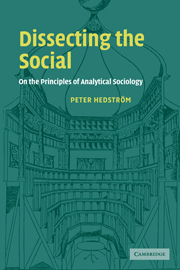Book contents
- Frontmatter
- Contents
- List of figures
- List of tables
- Preface
- 1 The analytical tradition in sociology
- 2 Social mechanisms and explanatory theory
- 3 Action and interaction
- 4 Social interaction and social change
- 5 On causal modelling
- 6 Quantitative research, agent-based modelling and theories of the social (with Yvonne Åberg)
- 7 Coda
- References
- Index
3 - Action and interaction
Published online by Cambridge University Press: 22 September 2009
- Frontmatter
- Contents
- List of figures
- List of tables
- Preface
- 1 The analytical tradition in sociology
- 2 Social mechanisms and explanatory theory
- 3 Action and interaction
- 4 Social interaction and social change
- 5 On causal modelling
- 6 Quantitative research, agent-based modelling and theories of the social (with Yvonne Åberg)
- 7 Coda
- References
- Index
Summary
In the previous chapter I focused on the characteristics of explanatory theories. I made a distinction between covering-law explanations, statistical explanations and mechanism-based explanations, and I suggested that the advancement of sociological theory largely hinges on our ability to develop precise mechanism-based theories. The main reason for this is that we arrive at more intellectually satisfying answers to the question of why we observe the social phenomena we observe if we specify the individual-level mechanisms likely to have brought them about. Furthermore, and as a side effect, this is likely to lead to more useful theories in that detailed knowledge of how things are brought about is useful if one wants to alter a process in a more desirable direction.
The most viable alternative to the mechanism-based approach is a statistical approach that directly examines the relationship between variables describing different entities. As the discussion in the previous chapter suggests, such an approach to theory building is prone to difficulties, and a ‘deeper’ causal account can be obtained by explicating mechanisms through which social patterns are likely to have been brought about. The types of mechanisms we are looking for are those concerned with the causes and consequences of individual actions, because, as Popper (1994) expressed it, actions are the ‘animating principles’ of the social.
- Type
- Chapter
- Information
- Dissecting the SocialOn the Principles of Analytical Sociology, pp. 34 - 66Publisher: Cambridge University PressPrint publication year: 2005



